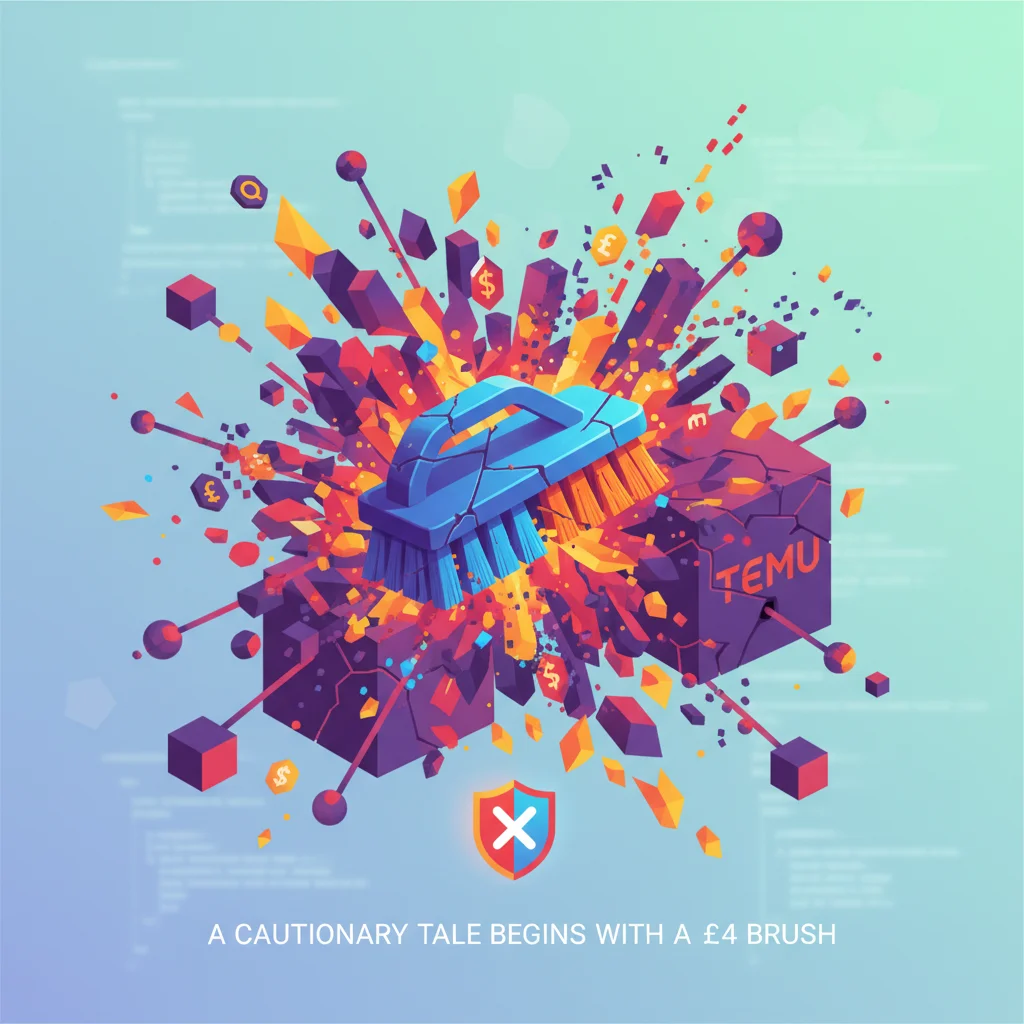
The £4 Brush Incident: A Micro-Crisis Exposing Macro Risks in Temu’s Business Model
A Cautionary Tale Begins with a £4 Brush
On the surface, it’s a minor consumer safety alert. A £4 cleaning brush, sold on the popular e-commerce platform Temu, was found to be dangerously defective after it ripped out a child’s hair. Following an investigation by Norfolk Trading Standards, the product was swiftly withdrawn from sale in the UK, as reported by the BBC. For most, the story ends there—a small mishap, a quick resolution. But for investors, business leaders, and financial analysts, this seemingly isolated incident is a critical signal flare, illuminating the deep-seated operational, reputational, and financial risks embedded within the ultra-fast, low-cost e-commerce model that has propelled Temu to global prominence.
This single product failure is not merely an anecdote; it is a case study in the inherent friction between explosive growth, rock-bottom pricing, and the unglamorous but essential pillars of quality control and supply chain integrity. It forces us to look beyond the tempting valuations and impressive user acquisition numbers to ask a more fundamental question: is this model sustainable? For those engaged in the worlds of finance, investing, and global economics, understanding the answer is paramount, as it carries significant implications for the stock market, competitive dynamics, and the future of retail itself.
Deconstructing Temu’s Disruptive Engine
To grasp the significance of a faulty brush, one must first appreciate the revolutionary business model of Temu and its parent company, PDD Holdings (NASDAQ: PDD). Launched in late 2022, Temu’s ascent has been nothing short of meteoric, challenging established giants like Amazon and eBay. Its success is built upon a Consumer-to-Manufacturer (C2M) model, which radically shortens the supply chain. Instead of traditional retail, where products move from manufacturer to wholesaler to distributor to retailer, Temu connects Western consumers almost directly with Chinese manufacturers.
This model offers several powerful advantages:
- Unbeatable Prices: By eliminating multiple intermediaries, Temu can offer products at astonishingly low prices.
- Agile Inventory: The platform uses real-time sales data to inform manufacturers what to produce, minimizing waste and the risk of unsold stock. This data-driven approach is a key piece of its financial technology infrastructure.
- Vast Selection: The direct-from-factory approach allows for an almost infinite “digital” shelf space, with new products added daily.
This operational efficiency, backed by a colossal marketing budget, has made PDD Holdings a darling of the stock market. The company’s valuation has soared, with its market capitalization briefly surpassing that of its Chinese rival, Alibaba, in late 2023 (source). For investors, the growth narrative is compelling. But as the £4 brush incident demonstrates, this high-velocity model also contains significant, often hidden, liabilities.
The Inevitable Trade-Off: Speed vs. Safety
The core tension within the Temu model is the trade-off between speed-to-market and rigorous oversight. When thousands of small, independent manufacturers are competing to produce goods at the lowest possible cost and get them onto the platform in days, not months, quality control can become a secondary concern. A traditional retailer invests heavily in vetting suppliers, conducting factory audits, and performing stringent product safety tests before an item ever reaches a shelf. In the C2M model, this responsibility is often decentralized, creating potential gaps in compliance and safety protocols.
The faulty brush is a tangible result of this trade-off. It represents a failure somewhere along this hyper-accelerated supply chain—a breakdown in material sourcing, manufacturing process, or final product inspection. While Temu acted to remove the product after being notified, the incident highlights a reactive rather than proactive approach to safety. For a company operating at this scale, a reactive strategy is a high-stakes gamble. The following table provides a comparative overview of the risk profiles associated with different e-commerce models.
This table illustrates the distinct risk-reward profiles for investors and executives evaluating the e-commerce sector.
| Feature | Traditional Retail (e.g., Target) | Marketplace Model (e.g., Amazon) | Ultra-Fast C2M (e.g., Temu) |
|---|---|---|---|
| Supply Chain Structure | Long-term, curated supplier relationships | Mix of first-party inventory and third-party sellers | Decentralized network of thousands of on-demand manufacturers |
| Quality Control | Centralized, multi-stage, and proactive | Shared responsibility; reliant on seller compliance and platform policing | Largely decentralized; potential for significant compliance gaps |
| Primary Financial Risk | Inventory overhead and capital expenditure | Counterfeit goods and seller fraud, impacting brand trust | Product safety liabilities, regulatory fines, and reputational damage |
| Investment Thesis | Stability, dividend yield, brand equity | Platform dominance, cloud services, network effects | Hyper-growth, market disruption, high-risk/high-reward |
The Investor’s Lens: ESG, Regulation, and Market Sentiment
For the modern investor, this incident resonates deeply within the framework of Environmental, Social, and Governance (ESG) criteria. Product safety is a cornerstone of the ‘Social’ and ‘Governance’ pillars. A single failure can signal broader systemic weaknesses in a company’s governance over its supply chain. A pattern of such failures could lead to ratings downgrades from ESG agencies, potentially excluding the stock from certain ethically-focused funds and portfolios.
Furthermore, Temu and similar platforms are facing a rising tide of regulatory scrutiny. In the United States, lawmakers are closely examining the “de minimis” rule, a trade provision that allows packages valued under $800 to enter the country tax-free and with less oversight. A significant portion of Temu’s shipments leverages this rule, and any changes could fundamentally alter its cost structure and profitability (source). This represents a major political and economic risk that anyone involved in trading PDD stock must consider. These regulatory headwinds, combined with public reports of product safety issues, can create significant volatility in the company’s stock price.
Decoding China's Next Decade: What the New Five-Year Plan Means for Global Investors
The financial markets are constantly pricing in these risks. While the growth story has so far outweighed the concerns for many, every negative headline chips away at consumer trust and attracts more regulatory attention. The long-term valuation of PDD Holdings will depend not just on its ability to acquire new customers, but on its ability to build a resilient and compliant operational backbone that can withstand the inevitable stresses of global scale.
Broader Implications for the Global Economy and Financial Technology
The rise of platforms like Temu is a macroeconomic event with far-reaching consequences. It is reshaping consumer behavior, accelerating the deflationary pressure on consumer goods, and creating new challenges for domestic manufacturers and retailers. From a banking and fintech perspective, the model’s reliance on a high volume of low-value, cross-border transactions is pushing the boundaries of payment processing and international settlement systems.
Looking ahead, the challenges exposed by the faulty brush incident point toward potential technological solutions. Imagine a future where supply chain transparency is not just a promise but a reality. Technologies like blockchain, while not a panacea, offer a theoretical framework for creating immutable records of a product’s journey from raw material to consumer. A manufacturer could log every component, every safety check, and every certification on a distributed ledger. While the implementation is complex and costly, the persistent risk of safety failures and the immense financial cost of recalls and reputational damage could eventually make such investments in deep financial technology and supply chain verification economically viable.
A Stark Admission: UK Chancellor Declares Brexit Deal Caused "Long-Term Economic Damage"
Conclusion: From a Single Brush to the Big Picture
The story of the £4 Temu brush is a powerful reminder that in our interconnected global economy, the smallest details can have the largest implications. It serves as a microcosm of the immense challenge facing the new wave of e-commerce giants: balancing disruptive innovation with fundamental corporate responsibility. For business leaders, it underscores the critical importance of supply chain visibility and proactive quality control. For policymakers, it highlights the need to adapt regulatory frameworks to the realities of a rapidly evolving digital marketplace.
And for the investment community, it is a clear signal that a thorough analysis must go beyond the top-line growth figures. The true, long-term value of a company like PDD Holdings will be determined by its ability to manage the complex, multifaceted risks that its own disruptive model creates. The next time a shockingly low price appears on your screen, it is worth considering the vast and intricate system of trade-offs—in quality, safety, and governance—that made it possible.


